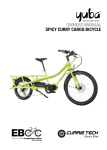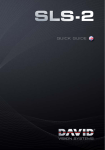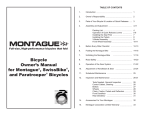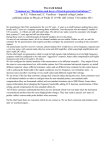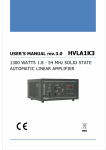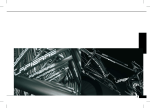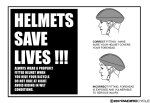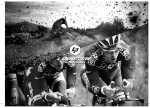Download Yuba Bicycles Boda Boda Owner`s manual
Transcript
1. 2. 3. 4. 5. 6. 7. 8. 9. 10. 11. 12. 13. 14. INTRODUCTION ........................................................................................................................................... 2 ASSEMBLY OF YOUR NEW BICYCLE .......................................................................................................... 2 GENERAL WARNING .................................................................................................................................. 2 OWNER’S RESPONSIBILITY ........................................................................................................................ 3 FIGURE OF THE YUBA BODA BODA AND PARTS DESCRIPTION................................................................ 4 ASSEMBLY AND ADJUSTMENT ................................................................................................................ 4 Assembly of the front wheel ................................................................................................................... 5 KNOW HOW THE BICYCLE PERFORMS ...................................................................................................... 6 Learn the power of your brakes ............................................................................................................... 6 Avoid toe-clip overlap .............................................................................................................................. 6 Stop riding if you have frame problems. ................................................................................................. 6 ROAD SAFETY ............................................................................................................................................. 7 OPERATING THE BIKE ................................................................................................................................. 8 Operating the brake system..................................................................................................................... 8 Operation of the gear system .................................................................................................................. 8 Adjustment of the Cable Tension: ........................................................................................................... 8 ADJUSTMENT OF HANDLEBAR AND SEAT ........................................................................................... 10 Handlebar stem adjustment: ................................................................................................................. 10 Seat adjustment: .................................................................................................................................... 10 SCHEDULED MAINTENANCE.................................................................................................................. 11 CARRYING LOADS WITH YOUR CARGO CRUISER BICYCLE .................................................................. 15 Getting to know your Cargo Cruiser Bicycle .......................................................................................... 15 Seating on the carrier seat .................................................................................................................... 15 Children .................................................................................................................................................. 15 Use good judgment ................................................................................................................................ 15 Pre-ride checklist ................................................................................................................................... 15 Kickstand ................................................................................................................................................ 16 Maximum payloads ................................................................................................................................ 16 Main Carrier or loading platform #1 ...................................................................................................... 16 Love Handles or lateral loading platforms #2 ....................................................................................... 16 Carrying long loads (ladder, surfboard, solar panels…) ....................................................................... 16 Carrying passenger and children ........................................................................................................... 16 ACCESSORIES FOR YOUR YUBA ............................................................................................................. 17 YUBA BICYCLES LLC LIMITED WARRANTY............................................................................................ 17 For more Information: ............................................................................................................................ 17 Limited Warranty ................................................................................................................................... 17 Yuba Bicycles LLC Boda Boda Cargo Cruiser [ Owner’s Manual v1.1] Page 1 1. INTRODUCTION CONGRATULATIONS on the purchase of your new YUBA. This manual is designed to give you the information you need for the safe operation and maintenance of your new bicycle. Please read it thoroughly before riding your bicycle. Your bicycle’s serial number is stamped on the kickstand plate of the bicycle. Record the serial number in this manual in the event that your bicycle is lost or stolen. Please register your serial number online: yubabikes.com/register MODEL NAME:________________________________________________________________ COLOR: ______________________________________________________________________ SERIAL NUMBER: _______________________________________________________________ DATE OF PURCHASE: _____________________________________________________________ PLACE OF PURCHASE: ____________________________________________________________ Since all the components on your YUBA are industry standard, repairs or replacements can be performed at virtually any retail bicycle dealer. If you have any questions about your YUBA bicycle after reading this manual, or encounter any please call YUBA’s Customer Support Team toll free at 877 889-YUBA. 2. ASSEMBLY OF YOUR NEW BICYCLE Assembly and the first adjustment of your bicycle take special tools and skills, it is recommend that this should be done by a trained bicycle mechanic. If you have any questions after reading the information in this manual, talk to your dealer or us. This manual conforms to these standards: CPSC CFR 1512 CEN 14764, 14765, 14766, 14872 3. GENERAL WARNING Like any sport, bicycling involves risk of injury and damage. By choosing to ride a bicycle, you assume the responsibility for that risk, so you need to know — and to practice — the rules of safe and responsible riding and of proper use and maintenance. Proper use and maintenance of your bicycle reduces risk of injury. •This Manual contains many “Warnings” and “Cautions” concerning the consequences of failure to maintain or inspect your bicycle and of failure to follow safe cycling practices. Yuba Bicycles LLC In this manual, the CAUTION sign indicates a hazardous situation, which, if not avoided, may result in minor or moderate injury In this manual, the WARNING sign indicates a hazardous situation, which, if not avoided, could result in death or serious injury. Boda Boda Cargo Cruiser [ Owner’s Manual v1.1] Page 2 • The combination of the ! safety alert symbol and the word WARNING indicates a potentially hazardous situation, which, if not avoided, could result in serious injury or death. • The combination of the ! safety alert symbol and the word CAUTION indicates a potentially hazardous situation, which, if not avoided, may result in minor or moderate injury, or is an alert against unsafe practices. • The word CAUTION used without the safety alert symbol indicates a situation, which, if not avoided, could result in serious damage to the bicycle or the voiding of your warranty. Many of the Warnings and Cautions say “you may lose control and fall”. Because any fall can result in serious injury or even death, we do not always repeat the warning of possible injury or death. Because it is impossible to anticipate every situation or condition, which can occur while riding, this Manual makes no representation about the safe use of the bicycle under all conditions. There are risks associated with the use of any bicycle which cannot be predicted or avoided, and which are the sole responsibility of the rider. 4. OWNER’S RESPONSIBILITY Before riding your YUBA bicycle, carefully follow all assembly instructions. • Ensure your bike is the correct size for your comfort and safety. When standing over the frame (straddle frame) you should have a minimum of 1.0” clearance between the boom tube and your body. Personal adjustment of the saddle is also necessary to assure maximum safety and comfort. Open the quick release lever on the seat tube and adjust the height of the saddle. When seated, your leg should be fully extended with the knee slightly bent and the ball of the foot on the pedal at the lowest pedal position. • Double check to ensure all bolts and screws are tight. • Make sure that anyone to whom you loan your YUBA understands how to operate the bike. The owner is responsible for required normal maintenance services, such as those listed in the “Maintenance” sections of this booklet (on page 11) in order to keep the bicycle in good operating condition. Yuba Bicycles LLC does not warrant damage or injury resulting from negligence, improper operation, improper or unauthorized repair or from maintenance, environmental influences, and improper use. Yuba excludes incidental and consequential damages. Yuba Bicycles LLC Boda Boda Cargo Cruiser [ Owner’s Manual v1.1] Page 3 5. FIGURE OF THE YUBA BODA BODA AND PARTS DESCRIPTION 6. ASSEMBLY AND ADJUSTMENT Although your YUBA bike is 85% assembled, there are a few steps that must be completed before it is ready to ride. If you have questions or concerns about any of these steps, please see a bicycle dealer or contact YUBA toll free at 877 889-YUBA. Carefully follow the “Final Assembly Instructions” attached to your bike. Once you have completed the assembly, read the remainder of this Owner’s Manual. Never attempt to ride a bicycle that is not properly assembled. Inside your box you will find: • 1 85% Assembled Cargo Cruiser with the rear wheel attached • 1 Saddle with seat post • 1 Handle bar, to be installed • 1 Front Wheel, to be installed • 1 Small Parts Box that includes: 2 Pedals (Right and Left), Stem Yuba Bicycles LLC Boda Boda Cargo Cruiser [ Owner’s Manual v1.1] Page 4 Carefully remove the bicycle and all accessories from the box to avoid scratching the frame. Check the carton for loose parts before discarding. Assembly of the front wheel Take the front wheel from the box and unscrew the large nuts. Insert the front wheel into the fork, center the wheel and then tighten the nuts using a wrench. Check that the wheels are properly attached. Bicycle wheels are attached by several systems: threaded axle nuts, a quick-release where a lever-actuated wheel retention mechanism allows the wheel to be installed and removed without tools, or a thru-axle where the axle is threaded through the ends of the frame or fork. Test for proper wheel attachment. Pick up the bike and sharply hit the top of the tire. The wheel must not come off, be loose, or move from side to side. Yuba Bicycles LLC A wheel attachment device that is not properly adjusted and closed may allow the wheel to be loose or come off unexpectedly, causing you to lose control and fall. Make sure the wheels are properly attached before riding the bike. Boda Boda Cargo Cruiser [ Owner’s Manual v1.1] Page 5 7. KNOW HOW THE BICYCLE PERFORMS The features of your bicycle, if misused, may cause you to lose control of the bike. Before riding fast or in more difficult conditions, learn the function and performance of all the mechanisms of your bike by riding at slower speeds in a flat, empty parking lot. If you want your bicycle to perform differently, or if you have special needs that require different parts for the safe operation of your bike, consult your bicycle dealer. Mis-use of the braking system, including over-use of the front brake, can cause you to lose control and fall. Avoid improper braking by understanding and practicing proper application of your brakes as explained in this manual. Learn the power of your brakes The stopping power on bikes varies according to the intended use of the bike. If you would like your bike to have more, or less, stopping power, consult your dealer about brake adjustments or other brake options for your bicycle. Avoid toe-clip overlap When riding slowly, do not pedal if the handlebar is turned. It may be possible, at very slow speeds, when the handlebar is turned, for your foot or toe-clips to contact the front wheel or fender (Figure 1). At normal riding speeds, the handlebar does not turn enough for this to occur. Contact between your foot or toe-clip and the front wheel or fender can cause you to lose control and fall. Avoid pedaling when turning at slow speed. fig 1- toeclip overlap Stop riding if you have frame problems. Occasionally riders experience problems with their frame or fork. If a frame or fork has any problem, do not ride the bicycle. As an example, in very rare cases, some riders may experience a “shimmy” or “harmonic oscillation” or “frame vibration” at certain speeds. If you are experiencing a shimmy, slow down immediately. Take your bicycle directly to a dealer for inspection and repair. Yuba Bicycles LLC A shimmy, or steering wobble, can cause you to lose control and fall. If you experience a shimmy, slow down immediately. Take your bicycle to your dealer for inspection and repair. Boda Boda Cargo Cruiser [ Owner’s Manual v1.1] Page 6 8. ROAD SAFETY • For your safety, always wear a helmet that meets Snell or American National Standards Institute (Ansi) Z290.4 requirements. In the event of an accident a helmet can protect you from serious injury and even death. A bicycle retailer will be happy to assist you in the selection of a helmet and other useful accessories. • Obey all traffic laws. Obey red and green lights, one-way streets, stop signs, etc. • Ride with the traffic, not against it. Ride single file in a straight line. • Have a satisfactory signaling device (bell, horn, etc.), to warn of approach. Ride defensively (expect the unexpected). • Give pedestrians the right of way. Do not ride too close to pedestrians and alert them if you intend to pass from behind. • Slow down at all street intersections and look to the right and left before crossing. • Always use proper hand signals for turning and stopping. Give signals 100 ft. before stopping or turning and always return both hands to the handlebars before stopping or turning. • Watch for cars pulling out into traffic and for sudden opening of car doors. • Avoid potholes, drainage grates or other road surface hazards. Cross railroad tracks at a right angle. Be careful when riding on soft road edges, gravel, sand and uneven surfaces. Ride slowly and avoid quick turns when riding on these surfaces. • Never hitch on other vehicles, do not “Stunt” ride or race in traffic. Don’t weave in and out of the traffic or swerve from side to side. • Never carry other riders or packages, they may obstruct vision or proper control of the bicycle. • Before riding, check your brakes. Be sure they are operating efficiently and that your bicycle is in perfect running condition. • When riding at night, always use lights, clear light on front and flashing red light on rear, and wear light colored and/or reflective clothing. Make sure your reflectors are intact and visible. Assume motorists are unable to see you and ride in an appropriately cautious manner. • When braking always apply stronger braking pressure to the rear wheel (right lever). If the front brake pressure (left lever) is applied too strongly or quickly, the bicycle may flip forward. Avoid strong braking while turning. CAUTION IN WET WEATHER RIDING No brakes work as well under wet conditions as they do under dry conditions. In rainy wet weather, special precautions must be taken to insure safety in stopping. Proper adjustment and cable lubrication will help, but the major precaution rests with you. Increased brake pressure is required in wet or rainy weather and care must be exercised to maintain safety under these conditions. Ride slower than normal and apply your brakes sooner than normal conditions would require. A crash can put extraordinary stress on bicycle components, causing them to fatigue prematurely. Components suffering from stress fatigue can fail suddenly, causing loss of control, or serious injury. Yuba Bicycles LLC Your bicycle is equipped with reflectors, however, extreme caution is required when traveling at dusk or night. In addition to keeping your reflectors clean, and properly affixed to your bicycle, you must use headlights and taillights, in addition to wearing bright, reflective clothing when riding in poor lighting conditions. Consult your local bike shop to find accessories appropriate for your riding needs. Boda Boda Cargo Cruiser [ Owner’s Manual v1.1] Page 7 9. OPERATING THE BIKE Operating the brake system Always keep a safe stopping distance between you and other vehicles or objects. Adjust stopping distances and braking forces to suit riding conditions. If your bike has two hand brakes, apply both brakes at the same time. Over-use, or mis-use, of a frontwheel brake, such as using only the front-wheel brake in an emergency, could cause the rear wheel to lift from the ground, which could cause you to lose control. Bicycles are normally manufactured with the left brake lever controlling the front-wheel brake. To change so that the right lever controls the front-wheel brake, see Chapter 3. Many models of modern brakes are very powerful; they are designed to stop a bike in wet or muddy conditions. If you feel your brakes are too powerful for your riding needs, take your bike to your dealer for adjustment or replacement of the braking system. Operation of the gear system The multi-gear system provides a means of maintaining a constant pedaling rate, regardless of road level conditions. This is the most effective cycling technique to prevent tiring over long distances. The gears are activated by cables connecting the twist shifters or shift levers located on the handlebar to the derailleurs. If your bicycle is equipped with twist shifters, rotating the twist shifters towards you moves the chain from one chainwheel (or sprocket) to the next larger chainwheel (or sprocket). Rotating the twist shifters away from you moves the chain from one chainwheel (or sprocket) to the next smaller chainwheel (or sprocket). If your bicycle is equipped with shift levers, pushing the thumb shift lever away from you moves the chain from one chainring (or sprocket) to the next larger chainring (or sprocket). Pulling the index finger shift lever towards you moves the chain to the next smaller chainring (or sprocket). The left shifter controls the front derailleur and the right shifter lever controls the rear derailleur. To shift, continue pedaling at a steady pace while operating the shifters and engage the gear you find most comfortable. For easiest pedaling (while going up-hill or slowly), position the chain over the smallest chainring in front and the largest sprocket in back. For hardest pedaling (while going down-hill, or quickly), position the chain over the largest chainring in front and the smallest sprocket in back. Pedals and wheels must be turning forward while shifting gears. Never pedal backward while shifting gears and never force the twist shifters or shift levers. Adjustment of the Cable Tension: If the gear system is not functioning properly, ensure that the rear derailleur follows each shifting command of the right twist shifter/shift lever. Cable stretching could affect the function after some time, so that synchronization may no longer be assured. Check and adjust as follows: Yuba Bicycles LLC Boda Boda Cargo Cruiser [ Owner’s Manual v1.1] Page 8 1. Shift the chain to the center of the front chainwheel by turning the crank forward and shifting the left twist shifter/shift lever. 2. Shift the chain to the outermost/smallest rear sprocket by turning the right twist shifter all the way away from you, or moving the right shift lever all the way towards you. 3. While turning the crank forward, rotate the right twist shifter or push the right shift lever to the next position. 4. The chain should move to the second rear sprocket after a maximum of one full turn of the wheel. If it stays on the first sprocket, the tension of the shifting cable must be increased (proceed to Step 6). 5. If the chain jumps across the second sprocket or if it scratches the third sprocket, the tension of the shifting cable must be decreased (proceed to Step 6). 6. Cable tension is adjusted by turning the Cable Adjusting Barrel, which is located at the junction of the cable and the rear derailleur (Fig. 16). To increase tension turn the knurled knob counterclockwise, to decrease tension, turn the knob clockwise. If the tension is adjusted according to the above steps, the chain should follow all shifting commands on the twist shifters. If the gear system still does not function properly, please contact a bicycle retailer for assistance. Yuba Bicycles LLC Boda Boda Cargo Cruiser [ Owner’s Manual v1.1] Page 9 10. ADJUSTMENT OF HANDLEBAR AND SEAT Handlebar stem adjustment: Your handlebar’s primary function is to steer and control your bicycle, therefore proper installation, adjustment and maintenance are crucial for your enjoyment and safety. To change the handlebar height, loosen the stem expander bolt two to three turns, then tap the top of the stem handlebars to the desired height, and retighten very tightly (175-260 lb.lin or 19.8-29.4Nm). MAKE SURE THE MINIMUM INSERTION LINE IS NOT SHOWING ABOVE THE HEADSET. Some bikes are equipped with a stem that has an adjustable rise, or angle. These bikes require that you tighten the angle adjusting bolt to 150-170 lb.lin (17-20.3 Nm) after first making sure the teeth are If you are unsure of the safety of your handlebar system, do not attempt to correctly engaged with the corresponding teeth entered between the ride your bike. Never ride your teeth of the mating part. bicycle with the stem raised above Note: Some bikes are equipped with the minimum insertion mark as this handlebar stems that are not adjustable may cause loss of control resulting in in height. personal injury or death. A minimum of 2 3/4 inches (70mm) of the stem Test the security of the handlebars in the must always remain in the frame. stem and the stem in the frame, by attempting to twist the handlebars in the stem and by attempting to turn them from side to side with the front wheel locked between your knees (Fig.5). Make sure there are no cables stretched or pinched by rotating the handlebars. Fig 5. Test of handlebar Seat adjustment: Your seat and seatpost are the primary means of support for the rider. Proper adjustment is important for your comfort and pedaling efficiency. Ensure your seat and seatpost are securely tightened in a comfortable position for your riding style. Ensure that the seat is secure by attempting to turn the seat and seatpost in the frame. Grabbing the saddle, attempt to move the front of the saddle up and down and side to side. If it rotates, is loose, or moves up and down, tighten the quick release and repeat the test until there is no movement. Yuba Bicycles LLC When adjusting the seatpost ensure the minimum insertion mark remains inside the frame. A minimum of 2 1/2 inches (64mm) of seatpost must remain in the frame. Riding with the seat raised above this height may cause loss of control resulting in personal injury or damage to your bike. Boda Boda Cargo Cruiser [ Owner’s Manual v1.1] Page 10 11.SCHEDULED MAINTENANCE We recommend that you take your bicycle in to an authorized bicycle dealer before riding it and then once a year for maintenance so that you can enjoy your YUBA Bike for as long as possible. Maintenance of your bicycle should include the following: Maintenance service by a dealer 1. Crank set: check play, adjust and retighten if necessary. 2. Head set assembly: check play, adjust and tighten if necessary. 3. Brake system: replace brake cables, check brake pads and replace if necessary, adjust lever play. 4. Gear system: grease shifting cables, check and adjust setting and indexing function. 5. Wheels: check alignment, realign if necessary. Check and adjust air pressure. 6. Chain: check, replace if necessary. 7. Tighten mounting bolts on handlebar, saddle, brakes and hubs. 8. Boom Tube quick release box: keep free of debris. 9. Quick releases: check function. Regular performance of these maintenance services will afford carefree enjoyment of your YUBA bike. Regular care preserves the value and safety of your bicycle. You can carry out the following care and inspection procedures yourself or bring the bicycle to a dealer for maintenance. We recommend that you do take your bicycle in to a dealer once a year for maintenance so you can enjoy your Yuba for as long as possible. Tools needed for maintenance of your Yuba bike: • Small adjustable wrench • Large adjustable wrench • Set of 4, 5, 6 mm Allen keys • Medium Phillips screwdriver • Slip-joint pliers • Flat thin open end wrench 15mm • Air pump • Tire levers GENERAL INSPECTION: Every week or two tighten all nuts and bolts. Check all hardware to see that no parts are worn or damaged, that there is correct fork and frame alignment, and that all components are seated in proper position. CLEANING: Clean the frame and all parts regularly with a moist cloth or sponge. Bicycle shops offer special cleaning agents for easy care. REFLECTORS: Reflectors should be kept clean, securely fastened and positioned for bicycle identification at night from front, rear and lateral visibility. Damaged units should be promptly replaced. CONTROL CABLES: Replace worn or damaged cables. Do not kink cables. Cables stretch with use; adjust accordingly. Keep control cable lubricated. Yuba Bicycles LLC Boda Boda Cargo Cruiser [ Owner’s Manual v1.1] Page 11 HANDLEBAR/STEERING: On some models, the handlebar stem may be adjusted for your comfort. The bearing of the fork in the frame (headset) should rotate easily without play. Adjustment of the headset requires special tools and should be performed by a bicycle mechanic. GRIPS: Replace worn grips. Make sure they fit snugly. BRAKES: The brake levers should be easy to operate without too much play. Too much play will cause insufficient braking power. The play is properly adjusted if the brake pads meet the rim fully when the brake lever is pulled one third of the way. Adjust the brake play by turning the adjusting nuts located at the junction of the brake cable and brake lever. When you have determined the proper setting, turn the knurled knob at the shaft of the adjusting bolt all the way down to the brake lever to lock the brake setting in place. • The right brake lever controls the rear brake. To tighten brakes, turn the adjusting nut clockwise. To loosen brakes, turn the adjusting nut counterclockwise. • The left brake lever controls the front brake. To tighten brakes, turn the adjusting nut counterclockwise. Too loosen, turn the adjusting nut clockwise. Note: Left and right controls are reversed on bicycles sold in some countries. Check brake pads regularly for wear and make sure they are properly toed in. Viewed from the side, the brake pads should be exactly at the height of the rim and slightly toed in the direction of the rotation of the wheel. The brake pads must display tread. When the tread is worn down, the brake pads must be replaced. For safety reasons, the brake cables must be replaced every 12 months. This should be included in the annual maintenance service by a certified bicycle repair and maintenance shop. ALIGNMENT: If the bicycle does not align properly, immediately bring to a bicycle mechanic or call Yuba’s Customer Support toll free at 877 889-YUBA. WHEELS: Make sure the axle nuts on the front wheel and rear wheel are properly closed. Wheels should be centered in fork or dropouts. Irregular noise from the wheels or the brakes touching the rim indicates that the wheel requires maintenance. Wheels should be checked regularly for spoke tightness and true alignment. WHEEL ALIGNMENT: Wheels should rotate smoothly without wobbling from side to side. Check the bearing play of the hubs by lifting the bicycle and spinning the wheel. The wheel should continue to spin for several rotations and finally cease spinning. To check the play of the hubs: try to move the rim from side to side between the fork. During this test, no substantial play should exist. If you detect play or if the wheel is difficult to turn, the hub bearings must be adjusted. Please contact a bicycle mechanic to have the hub bearings adjusted. RIMS: The rims must be smooth and without cracks, breaks, or bulges. Check that they are smooth on the inside to prevent puncturing the inner tube. SPOKES: Check spoke tension regularly. Approximately the same tension should be applied to all spokes. If there is minor loosening of the spokes, you may tighten the nipples, but it is recommended that you take Yuba Bicycles LLC Boda Boda Cargo Cruiser [ Owner’s Manual v1.1] Page 12 the bicycle to a bicycle mechanic. If you detect a loose spoke or if the rim has a side play of more than 4mm, immediately have the wheel trued by a technician. Riding with loose spokes may cause the wheel to fail, resulting in serious injury or death. TIRES: Maintaining proper inflation levels of your tires ensures a smooth, efficient and safe ride. Make sure that the tires are inflated according to pressure indicated on tire sidewall. Improper tire pressure will cause excessive wear, causing premature replacement. A foot or frame pump should be used. Pressurized, unregulated pumps should not be used. The tire should be properly seated in the rim and the fitting of the tire bead and rim bead should be checked. If the tube is pinched between the tire and the rim, it will explode when inflated. Ensure that the tire is not cracked or unevenly worn. Check for bulges. Check that the valve is straight in the rim. Irregular tires should be replaced immediately. CHAIN: Check frequently for damage and stretch and replace if necessary. Lubricate several times each season and after each washing or ride in the rain. Use a lightweight, all-purpose oil, being careful to oil each link. Chain specific oil is available from any bicycle shop. The chain must be replaced after a maximum of 1250 miles. This requires special tools and should be performed by a certified bicycle mechanic. CHAINRINGS: Replace if chainring teeth are bent or damaged. Keep chainrings tight on crank. CRANKS& PEDALS: Crank assembly should turn freely without side play. Check the bearing play of the cranks by grasping the end of the crank near the pedal thread and trying to wiggle it laterally. If you detect play, have it corrected by a dealer. Keep locknut tight and keep bearings clean and well adjusted. Check crank bolt or nut (depending on axle type) regularly to make sure crank arms stay tight. Replace bent cranks immediately! Do not attempt to straighten. Replace pedals if bearings are tight or frozen and if thread is lost or badly worn. Keep pedal bearings lubricated. REFLECTORS: Your reflectors are an important safety feature of your bike, do not remove them. Every three months, check the nuts and bolts holding the front, rear, pedal and wheel reflectors and make sure that they are tight. Also check the alignment of the front and rear reflectors; their reflective surfaces should be perpendicular to the ground. The rear reflector should be at least three inches below the top of the seat. KEEP REFLECTORS CLEAN AT ALL TIMES. FRONT DERAILLEUR ADJUSTMENT: The derailing cage must be positioned high enough to clear the chain wheels while shifting. If an adjustment is necessary, loosen the frame clamp and reposition accordingly. When re-tightening the frame clamp bolt, make sure the curvature of the derailing cage is concentric to the curvature of the chainwheel and that the derailing cage is in line with the chainwheel. The front derailleur should shift smoothly and easily between the chainwheels. If the front derailleur does not shift correctly, it can be adjusted as follows: Yuba Bicycles LLC Boda Boda Cargo Cruiser [ Owner’s Manual v1.1] Page 13 1. Place left lever all the way forward, or twist shift all the way back, and adjust screw “H” to center derailing cage and chain over the large chainwheel. 2. Move left shift lever all the way back or twist shift all the way forward and adjust limiting screw “L” so the derailing cage and chain are centered over the smaller chainwheel. 3. Loosen the cable anchor nut and pull all slack out of the cable through the anchor bolt. Re-tighten the cable anchor bolt securely. These adjustments will limit the inward and outward movement of the derailing cage so the chain will not derail to the left of the inside chainwheel or to the right of the outside chainwheel. REAR DERAILLEUR ADJUSTMENT: With the right shift lever all the way back or the twist shift all the way forward, the rear derailleur should position the chain on the smallest rear sprocket with no trace of slack in the control cable. If the chain does not reach the smallest sprocket: Adjust limiting screw “H” (moving it out, away from the derailleur housing) allowing the necessary additional outward travel of the derailleur. Once adjusted, limiting screw “H” should be moved to bottom against the derailleur housing, stopping any additional outward travel of the derailleur and preventing the chain from running off the smallest sprocket. If there is slack in the cable: Turn the barrel adjustment counterclockwise to remove slack. If the slack is not taken up, or if the derailleur does not have a barrel adjuster, a cable adjustment is necessary. Loosen the cable-fixing bolt freeing the cable. Pull the cable tight and retighten bolt securely. With the right shift lever all the way forward, or the twist shift all the way back, the derailleur should position the chain on the largest rear sprocket. If the chain does not reach the largest sprocket: Adjust limiting screw “L” to allow for this and position it to bottom against the derailleur housing to prevent any additional inward travel of the rear derailleur. This will stop the chain from running off the inside of the large rear sprocket. Yuba Bicycles LLC Boda Boda Cargo Cruiser [ Owner’s Manual v1.1] Page 14 12.CARRYING LOADS WITH YOUR CARGO CRUISER BICYCLE Getting to know your Cargo Cruiser Bicycle Carrying a load and riding a medium-wheelbase bike both require getting accustomed to. Practice maneuvering and braking on a flat, hazard- and traffic-free street with and without a load before going out into the world. Carrying a seated passenger or heavy load involves risks, foremost of which can be decreased braking power and increased stopping distance. Always make sure you have at least two welladjusted brakes. Drum, roller, or coaster brakes are not suited to hilly riding or heavy loads and can fail under serious strain—when you need them most! We strongly recommend rim and/or disc brakes, though these carry their own risks: under severe loads (as when carrying a passenger or cargo at high speed a very strong front brake can lead to failure of the front fork. For this reason, don't use the front brake by itself; the rear or rear and front brake should be used in all braking situations. Seating on the carrier seat Standing, kneeling, or sitting backwards or sideways (both legs on the same side of the bike) on the carrier seat while the bike is moving or stopped can easily result in broken limbs, loss of control of the bike, destroyed rims, a destroyed bike frame, or worse. Children The user of this product acknowledges both an understanding and an assumption of the risks involved in cycling, cycling with cargo, and cycling with a passenger. Children incapable of riding a bike on their own or under the age of four should not ride on the Boda Boda as passengers, unless it's equipped with an approved Child Seat accessory. Children should not ride as passengers without an adult operating the Boda Boda Bicycle. When carrying children older than four years old, a passenger handlebar, and feet support must be installed on the bike. Use good judgment No warning is a substitute for good judgment. Use yours always. If you have reason to suspect that your own judgment isn't great, share your plans with somebody you respect, and ask for a second opinion. Pre-ride checklist • • • • • That no straps are dangling where they could get caught in the wheels. That no bag or box or any item are in a position where they could be caught in the spoke Double-check your load for security and stability. That your brakes are well adjusted Check to see that your wheels are securely fastened, Yuba Bicycles LLC Always make sure you have at least two well-adjusted brakes. Under severe loads (as when carrying a passenger or cargo) at high speed a very strong front brake can lead to failure of the front fork. The load(s) attached or placed on the carrier off the Utility Bicycle have to be securely fastened. Check that no edges or parts of the load can get in contact with moving parts of the bicycle. Boda Boda Cargo Cruiser [ Owner’s Manual v1.1] Page 15 • • • That your helmet (and head) is securely fastened, That no components or frame members are cracked or broken (in general, if at any time you notice a crack or bend in your bike, stem, forks, or bars of your bicycle, stop riding immediately; take your rig to your local bike shop and have them inspect it) That your bike is equipped with the proper passengers accessories (childseat, foot pegs, handle bar, wheelskirts). Kickstand A bicycle kickstand is provided with the Boda Boda Bicycle. It is important to understand that kickstands are not designed for heavy loading or passenger loading. The user should always hold on to the bike when loading it. Or the user can have the bike leaned against a wall, a pole to prevent the falling over of the bicycle. Maximum payloads For the carrier: 100kg/ 220lbs Behind axle: 20kg/ 44lbs Love Handles: 20kg/ 44lbs (each side) Kickstand: 50kg/ 110lbs The kickstand gives the bike only limited stability. Be especially careful with precious cargo and children. DO NOT ASSUME THAT THE BIKE IS BALANCED WHEN USING A KICKSTAND! ALWAYS HOLD ON TO THE BIKE WHEN LOADING CHILDREN! Main Carrier or loading platform #1 The carrier is the space to be used for the transport of boxes, baskets, and cartons… It is essential to position the load properly, and to securely attach it to the carrier using a rope, cam straps or some type of bungee cord. Love Handles or lateral loading platforms #2 The two horizontal racks are the platform for carrying wide or big boxes, they are essentials to carry long objects: ladder, kayaks, or lumber. They can also be used for passenger’s feet support. Carrying long loads (ladder, surfboard, solar panels…) Long loads up to 5m (or 15 ft) can be carried on the lovehandles platform(s) of the Boda Boda Cruiser bike. In some cases a block (foam for example) might be needed to keep the load(s) away from the pedal(s). Carrying long loads on the non-kickstand side of the bike helps keep the load(s) away from moving traffic and facilitate mounting on the bicycle. Carrying passenger and children Carrying passengers by bicycle is subject to limitations and regulations in most countries. Check local traffic and regulations to learn more and comply with the law. Yuba Bicycles LLC Children are your most precious cargo, always be extra careful when operating the bike with 1 or more kids on the back of the bicycle. NEVER LEAVE THE BIKE UNATTENDED WITH CHILDREN ON THE BICYCLE! Boda Boda Cargo Cruiser [ Owner’s Manual v1.1] Page 16 Carrying children on a bicycle should only be done when using approved and certified child seat and equipment. Please call us or visit the nearest bicycle dealer for more information. We recommend that you always use Wheelskirts when carrying children. ! For more tips and pictures on how to carry loads by bicycle, visit yubabikes.com 13.ACCESSORIES FOR YOUR YUBA Keep feet and hands away from moving wheels. Contact with wheel can result in injury. To reduce the risk of injury, use Wheelskirts when carrying Children. Optional Accessories: • Wheelskirts for children • Baguette bag, large weatherproof pannier • Soft spot seat • Boda Double kickstand, two leg kickstand for easy loading • Straps, 3 meters straps • Peanut Shell Child seat • Bamboo Running Boards • Bread Basket front rack More Yuba accessories are also available, and since your Yuba uses standard parts and components, you can customize your bike in numerous ways. Check out your local bike dealer’s selection of parts and accessories. 14.YUBA BICYCLES LLC LIMITED WARRANTY For more Information: If you would like additional information about your bicycle, maintenance, or bicycling in general, there are many resources in your community. First, talk to your bicycle dealer. They have extensive experience with bicycles and riding in your community. With this background, they can help you with your individual questions and help you find areas to enjoy your new bicycle. In addition, most dealers stock a variety of book about cycling, including extensive repair manuals. Second, check your public library. Most libraries have extensive offerings of books written by experts in the field about riding, racing, bicycle safety, bicycle maintenance, and more. Third, go on-line. The companies that make the parts of your bike offer information and help is just a click away. Limited Warranty The Boda Boda frame including carrier and lovehandles platforms are warranted against breakage for two years from date of purchase to be free from defects in materials and workmanship subject to the conditions Yuba Bicycles LLC Boda Boda Cargo Cruiser [ Owner’s Manual v1.1] Page 17 and limitations set forth below. Yuba's sole obligation under this warranty is to repair or replace the product(s), at Yuba's option. The components and parts assembled on the Boda Boda are not covered under this warranty. This warranty does not cover damage due to wear and tear, overloading, misuse, abuse, or anything else beyond Yuba’s direct control. A partial list of preventable damage not covered by this warranty: rusting of the Boda Boda frame; bending of the Boda Boda 's chainstays by overloading behind the dropouts; failure of the Boda Boda 's rear wheel; bending of the carrier or the love handles. Yuba will be the sole arbiter of whether or not damage is due to defects in materials and workmanship. This warranty applies only to the original owner and is nontransferable. Prior to servicing a warranty customer, you must request authorization for return, repair or replacement from Yuba or your regional distributor. Warranty claims require proof of purchase and must be made through an authorized dealer. Any postage, insurance or shipping costs incurred in sending your Yuba components for service are your responsibility. Yuba Bicycles LLC Boda Boda Cargo Cruiser [ Owner’s Manual v1.1] Page 18



















